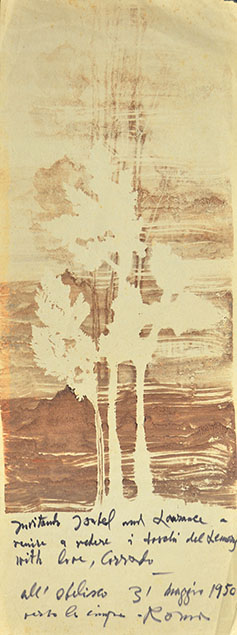(Ancona 1910 - Rome 1976 )
TREES, 1950
Monotype in brownish ink. Dedicated, signed, located and dated Invitando Iortel and Lawrence a / venire a vedere I boschi del Lemory (?) / with love Corrado / all'obelisco 31 maggio 1950 / verso le cinque - Roma. 555 x 212 mm.
Born in Ancona, Italy, Cagli became an exceptional artist in a new generation of art in the first half of the Twentieth Century. With other up and coming artists of the period, Giuseppe Capogrossi and Emanuele Cavalli, they became know as the New Roman School of Painting. He painted well known murals in his early years and went on to experiment in a Neo-Cubist style and metaphysical works.
In 1932, Cagli inaugurated a solo show with Adriana Pincherle at the Galleria di Roma. In December 1933, he moved to Paris, where he exhibited with Capogrossi, Cavalli, and Sclavi at the Galerie Jacques Bonjean. The exhibition was presented in the catalog by the critic Waldemar George, who put together the four young artists under the label of Jeune École de Rome.
In 1938, when Mussolini stepped up the persecution of Jews, Cagli fled to Paris and later went to New York where he became a U.S. citizen. He enlisted the U.S. Army and was involved in the 1944 Normandy landings, and fought in Belgium and Germany. He was with the forces that liberated the Buchenwald concentration camp, and executed a series of dramatic drawings on that subject. In 1948, Cagli returned to Rome to take up permanent residence there. From that time forward, according to his method of multiple search, he experimented in various abstract and non-figurative techniques (neo-metaphysical, neo-cubist, informal). Corrado Cagli was awarded the Guggenheim prize (1946) and the Marzotto prize (1954).
